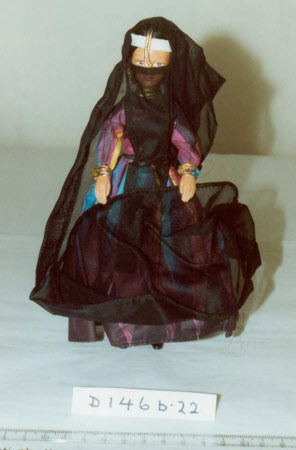Costume doll
Peggy Nisbet
Category
Dolls
Date
circa 1960 - circa 1969
Materials
Plastic doll
Measurements
195 mm (height)
Place of origin
England
Order this imageCollection
Sudbury Hall Museum of Childhood, Derbyshire
NT 658956
Summary
A costume doll representing a woman from Egypt, made by Peggy Nisbet, 1960s, series number N. 136 from the 'National Costume Dolls' range. The doll with plastic head and moulded features, the facial features painted. With black hair possibly of nylon, plaited and coiled into buns at the back of the head. The body plastic and moulded in one with the head and rigid legs. The arms are jointed at the shoulder and move independently. The doll wears a black organza yashmak, a white headband with a gold decoration over the forehead.The long organza scarf attached at the waist and headband, wrapped around the body and attached to the back of the skirt. Beneath the yashmak the doll wears a pink, purple, blue and black dress with long sleeves and gold braid trim at the neck and wrists, and white pantaloons. The feet are painted black to simulate shoes. Attached to the inside of the skirt is a label which reads 'Collectors Costume Dolls by Peggy Nisbet, Made in England' on one side, and on the other 'National Costumes, N136, Egypt'. Costume dolls representing people of different nationalities in their local dress have been made since the mid-19th century. As global travel expanded ‘world’ dolls were produced as tourist souvenirs as well as children’s toys. They appear in a variety of media, from paper to porcelain, polymer to plastic. Produced to be instantly recognisable and collectible, ‘world’ dolls can portray a stereotypical view of peoples and cultural identities.
Provenance
One doll from a collection of costume dolls donated by Mr R.T. Macfarlane in 1976.
Makers and roles
Peggy Nisbet , maker
